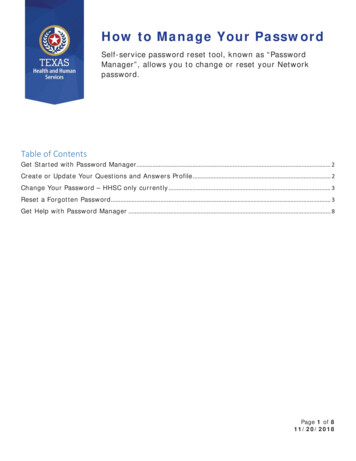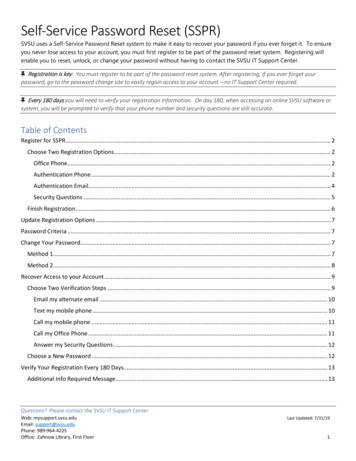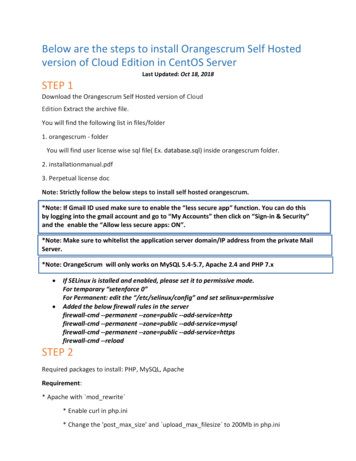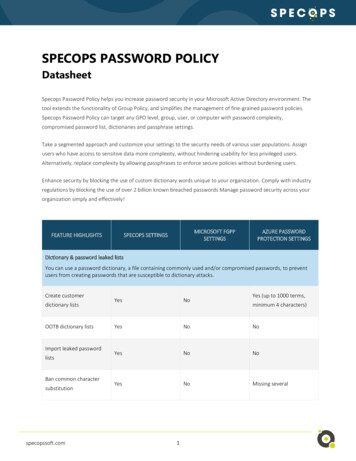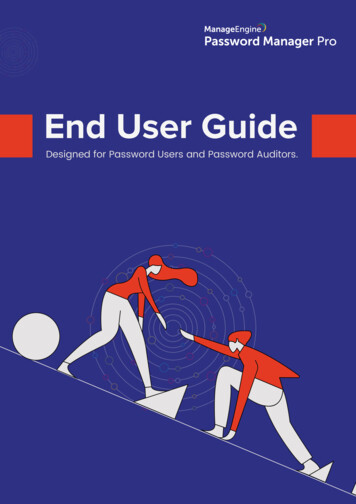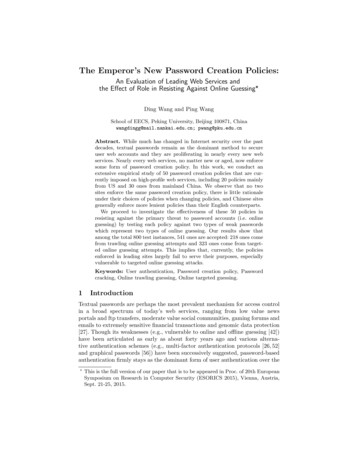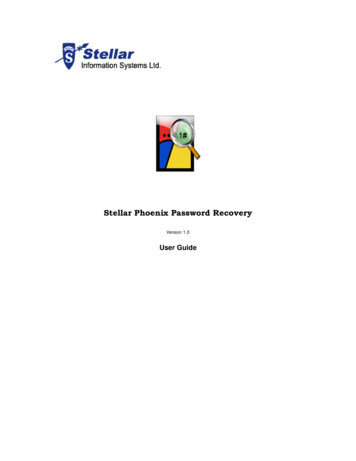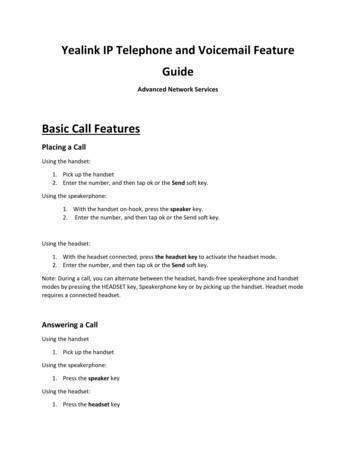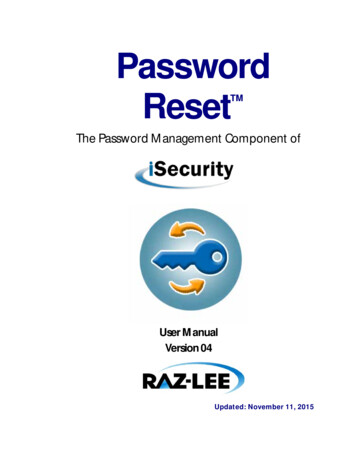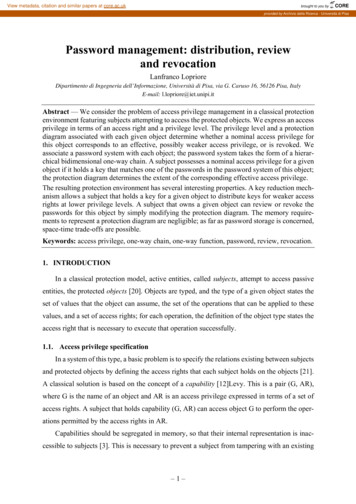
Transcription
View metadata, citation and similar papers at core.ac.ukbrought to you byCOREprovided by Archivio della Ricerca - Università di PisaPassword management: distribution, reviewand revocationLanfranco LoprioreDipartimento di Ingegneria dell’Informazione, Università di Pisa, via G. Caruso 16, 56126 Pisa, ItalyE-mail: l.lopriore@iet.unipi.itAbstract — We consider the problem of access privilege management in a classical protectionenvironment featuring subjects attempting to access the protected objects. We express an accessprivilege in terms of an access right and a privilege level. The privilege level and a protectiondiagram associated with each given object determine whether a nominal access privilege forthis object corresponds to an effective, possibly weaker access privilege, or is revoked. Weassociate a password system with each object; the password system takes the form of a hierarchical bidimensional one-way chain. A subject possesses a nominal access privilege for a givenobject if it holds a key that matches one of the passwords in the password system of this object;the protection diagram determines the extent of the corresponding effective access privilege.The resulting protection environment has several interesting properties. A key reduction mechanism allows a subject that holds a key for a given object to distribute keys for weaker accessrights at lower privilege levels. A subject that owns a given object can review or revoke thepasswords for this object by simply modifying the protection diagram. The memory requirements to represent a protection diagram are negligible; as far as password storage is concerned,space-time trade-offs are possible.Keywords: access privilege, one-way chain, one-way function, password, review, revocation.1. INTRODUCTIONIn a classical protection model, active entities, called subjects, attempt to access passiveentities, the protected objects [20]. Objects are typed, and the type of a given object states theset of values that the object can assume, the set of the operations that can be applied to thesevalues, and a set of access rights; for each operation, the definition of the object type states theaccess right that is necessary to execute that operation successfully.1.1. Access privilege specificationIn a system of this type, a basic problem is to specify the relations existing between subjectsand protected objects by defining the access rights that each subject holds on the objects [21].A classical solution is based on the concept of a capability [12]Levy. This is a pair (G, AR),where G is the name of an object and AR is an access privilege expressed in terms of a set ofaccess rights. A subject that holds capability (G, AR) can access object G to perform the operations permitted by the access rights in AR.Capabilities should be segregated in memory, so that their internal representation is inaccessible to subjects [3]. This is necessary to prevent a subject from tampering with an existing–1–
capability to amplify the access rights it contains, or even forging a capability from scratch.Several solutions have been devised to the capability segregation problem. Special memorysegments, which we shall call the capability segments, can be reserved for capability storage(in contrast, data segments will be reserved for storage of ordinary information items) [4], [9],[23]. This solution leads to segment proliferation. The resulting programming paradigm is oftenunnatural, e.g. the representation of a data structure must include a capability segment storingthe capabilities for the data segments. Alternatively, capability segregation can be obtained bytaking advantage of a tagged memory system that associates a 1-bit tag with each memory cell;the value of the tag of a given cell indicates whether this cell contains a capability or an ordinaryinformation item [7], [18]. In this approach, the instruction set of the processor includes specialinstructions for capability processing; if one of these instructions is executed on a memory celltagged to contain an ordinary information item, an exception of violated protection is raisedand execution fails. Contrary to hardware standardization [16], ad-hoc memory modules arenecessary to support cell tags (e.g. a 65-bit cell is used to store a 64-bit memory word).In a different approach, a set of passwords is associated with each protected object, andeach password corresponds to a subset of all access rights [1], [2], [6], [15], [19]. In order toaccess an object to perform a given operation, a subject presents a key for this object. The accessis successful only if the key matches one of the passwords associated with the object, and thispassword includes the access right required by that operation; if this is not the case, an exceptionof violated protection is raised and the object access fails.Keys are protected from forging by the password size; if passwords are large, the probability of guessing a valid key is vanishingly low. It follows that keys do not need to be segregatedin memory; instead, they can be freely mixed with ordinary data. This simplifies software composition in memory. Furthermore, no need for special hardware is connected with the necessityto store cell tags.1.2. Access right distributionA subject S that holds a set of access rights for a given object G should be in a position todistribute these access rights, in full or in part, to other subjects. In a capability environment, aresult of this type is obtained by a simple action of a capability copy (and indeed, simplicity inaccess right distribution was one of the original motivations for the introduction of the capability concept [12]).In a password-based protection system, subject S that possesses a key k for object G can–2–
distribute the access privilege corresponding to this key to another subject by simply transmitting a copy of the key. A related problem is that of key reduction. Subject S should be given theability to transmit only a subset of the access rights corresponding to key k. This means that amechanism of the protection system should allow S to convert k into a weaker key k’. The keyreduction problem can be easily solved by associating an object manager with each given object. In a situation of this type, subject S transmits key k to the object manager that verifies thevalidity of k and then generates a key k’ matching a weaker password; k’ is returned to S. Ofcourse, the presence of an object manager tends to complicate the overall object structure, andis contrary to a main requirement of a protection system design, i.e. simplicity in access rightmanagement.1.3. Access right review and revocationA subject that granted an access privilege to another subject should be allowed to revisethe grant and revoke the access privilege from the recipient. Revocation should extend to allthe subjects that received the privilege being revoked from the first recipient, recursively. Revocation should be reversible, so that after a given access privilege has been revoked, it shouldbe possible to confirm this access privilege and restore its validity.Several solutions to the revocation problem have been proposed with reference to capability-based protection environments [14]. These include a reference monitor associated with thegiven object that manages the access permissions held by all subjects on this object [17], [22];a propagation graph for each capability that keeps track of all successive transferals of thiscapability throughout the system [5]; and short-lived capabilities, whose validity must be renewed periodically, and are implicitly revoked if renewal is lacking [11]. These solutions tendto subvert the main advantage of the capability-based protection model, i.e. simplicity in accessright transmission between subjects [13].In a password-based protection environment, a subject that receives a key is free to transmitthis key further, and this key diffusion process may well extend to any transition depth. Thismeans that access rights tend to propagate throughout the system. A simple solution to the revocation problem is to modify one or more passwords associated with the given object, so thatthe corresponding keys lose their validity. This solution does not meet the requirement to limitrevocation to a subset of the access rights associated with the given password.This paper presents a model of a password management system that has been designed bytaking the following requirements into account: A simple mechanism for access privilege distribution should permit effective forms of key–3–
reduction, so that a subject that holds a given access privilege can transmit this privilegeonly in part. Password review and revocation should be fully supported, so that the extent of a givenpassword can be restricted to a subset of the original access rights. The consequence of apassword review should extend to all keys matching the reviewed password. It should bepossible to revert the effect of a password review and restore full password validity. The memory requirements for storage of the passwords and the information items relatedto password management should be kept to a minimum.The rest of this paper is organized as follows. Section 2 presents our protection model withspecial reference to access privileges and passwords. The concept of a protection diagram isintroduced expressing a relation between the nominal access privilege connected with a password and the effective access privilege granted by possession of a key matching that password.Section 3 presents the password system with special reference to password generation and management. Section 4 discusses the protection model from a number of salient viewpoints, whichinclude the verification, review and revocation of access rights, and the memory requirementsfor storage of the passwords and the protection diagram. Section 5 gives concluding remarks.2. THE PROTECTION MODELLet T be an object type, and let op0, op1, be the operations that can be applied to theobjects of type T. Furthermore, let ar0, ar1, , arr-1 be the access rights, and let pl0, pl1, , plc-1be the privilege levels defined by T, where quantities r and c are specific to T. Privilege levelsare involved in password validation, review and revocation, as will be illustrated shortly.The access rights are ordered from the weakest ar0 to the strongest arr-1. Possession ofaccess right ari implies possession of every weaker access right ari’, i’ i. Similarly, the privilege levels are ordered from the lowest pl0 to the highest plc-1.An access privilege for an object G of type T is the specification of an access right and aprivilege level. Let Pnom (ari, plj), 0 i r – 1, 0 j c – 1, be a nominal access privilegeexpressed in terms of access right ari and privilege level plj. Pnom grants its holder an effectiveaccess privilege Peff (ar*, plj) expressed in terms of access right ar* and the same privilegelevel plj, where ar* is not stronger than ari. The actual extent of ar* is stated for object G by arelation existing between the access rights and the privilege levels. This relation is specific toG, and is expressed by a diagram, which is associated with G and is called the protection diagram of G.–4–
Figure 1. Protection diagrams featuring four access rights and five privilege levels, in a variety of configurationsof the protection line.The protection diagram is defined in a two-dimensional Cartesian coordinate system. Inthe protection diagram, the horizontal axis refers to the access rights, from ar0 to arr-1, and thevertical axis refers to the privilege levels, from pl0 to plc-1. The protection line is a polygonalchain whose vertices are access privileges that we call the limit privileges, with the constraintthat at least one limit privilege must be associated with each access right. Figure 1 shows examples of protection diagrams featuring four access rights, ar0 to ar3, and five privilege levels,pl0 to pl4. The protection line divides the protection diagram into two regions: a validity regionthat includes the protection line and corresponds to higher privilege levels, and a downgraderegion that corresponds to lower privilege levels.In the example of Figure 1a, the limit privileges are (ar0, pl1), (ar1, pl2), (ar2, pl2), and (ar3,pl4). The protection line connects the corresponding points of the protection diagram. The validity region occupies the upper-left part of the diagram and includes the protection line; thedowngrade region occupies the lower-right part. In Figure 1b, the limit privileges are (ar0, pl4),(ar1, pl3), (ar1, pl2), (ar2, pl2), and (ar3, pl1). The validity region occupies the upper-right part–5–
of the diagram and includes the protection line; the downgrade region occupies the lower-leftpart. In Figure 1c, the protection line is horizontal and connects limit privileges (ar0, pl4), (ar1,pl4), (ar2, pl4), and (ar3, pl4). The validity region degenerates into the protection line. Finally,in Figure 1d the protection line is horizontal and connects limit privileges (ar0, pl0), (ar1, pl0),(ar2, pl0), and (ar3, pl0). In this case, the validity region occupies the whole protection diagram.For the given nominal access privilege, the protection line and the two protection regionsdetermine the corresponding effective privilege. Let us refer again to nominal privilege Pnom (ari, plj) and the corresponding effective privilege Peff (ar*, plj). If Pnom is in the validity region(including the protection line), nominal access right ari is effective, that is, ar* ari and consequently Peff Pnom; a subject S that possesses Pnom is granted access right ari. If Pnom is in thedowngrade region, access right ari is downgraded to the strongest access right ar* at protectionlevel plj that is weaker than ari and is included in the validity region. If ari cannot be downgraded into the validity region, then access privilege Pnom grants no access right at all; in asituation of this type, we say that Pnom is revoked.In the example of Figure 1a, nominal access privilege (ar1, pl3) is in the validity region,and is effective; a subject that possesses this access privilege is granted access right ar1. Nominal privilege (ar3, pl3) is in the downgrade region, and the corresponding effective privilege is(ar2, pl3); a subject that possesses (ar3, pl3) is granted access right ar2. Similarly, nominal privilege (ar2, pl1) is in the downgrade region, and the corresponding effective privilege is (ar0, pl1).Finally, nominal privilege (ar1, pl0) is in the downgrade region and cannot be downgraded intothe validity region, so it is revoked (this access privilege grants no access right at all). In theexample of Figure 1b, nominal privileges (ar3, pl3) and (ar3, pl1) are in the validity region, andare effective. Nominal privilege (ar1, pl1) cannot be downgraded into the validity region, and isrevoked. In the example of Figure 1c, all nominal privileges are revoked except those definedin terms of the highest privilege level, pl4, which are effective. Finally, in the example of Figure1d, the validity region occupies the entire protection diagram, so all nominal privileges areeffective.In every given object type, the strongest access right arr-1 is called the own access right;possession of this access right for a given object makes it possible to delete the object and tomodify its protection line (that is, to modify the position of the limit privileges in the protectiondiagram). Access privilege (arr-1, plc-1) corresponding to the own access right at the highestprivilege level is called the owner privilege. A subject that creates a new object (the objectowner) is granted the owner privilege for this object. When an object is created, a protectiondiagram is associated with that object, and the shape of the protection line is determined as part–6–
of the object initialization.An important property is that, in the protection diagram, all privileges at privilege levelplc-1 are always in the validity region; it follows that the owner privilege is always effective.Consequently, a subject that creates an object is always in a position to delete this object and tomodify its protection line; as will be shown shortly, an action of this type corresponds to a formof review or revocation of access privileges.3. THE PASSWORD SYSTEMLet us refer again to type T, where ar0, ar1, , arr-1 are the access rights, pl0, pl1, , plc-1are the privilege levels, and Pnom (ari, plj), 0 i r – 1, 0 j c – 1, are the nominal accessprivileges. We shall refer to the generic operation op defined by T, arop being the access rightnecessary to execute this operation successfully. In our protection model, for each object G oftype T, a password system is associated with G featuring a password for each nominal accessprivilege, for a total of r c passwords. In order to access G to execute operation op successfully,a given subject S must present a key k matching a password in the password system, say password wi,j. Implementation of operation op includes the actions necessary to determine the effective access privilege Peff (ar*, plj) corresponding to the nominal access privilege Pnom (ari, plj) associated with wi,j; to this aim, op uses the protection diagram of G. Execution ofoperation op will terminate successfully only if ar* is stronger than or equal to access right arop;if this is not the case, execution terminates with failure.A related problem is the generation of the set of passwords for object G. We solve thisproblem by taking advantage of one-way chains.3.1. Password generationFunction F is one-way if it is easy to compute but hard to invert [10]. This means that givena value x it is computationally easy to compute F(x), but given a value y it is computationallyunfeasible to find a value x such that y F(x). We shall denote i successive applications of F byFi, e.g. F2(x) F(F(x)). A one-way chain [8] is a collection of values (v0, v1, , vn-1) such thateach vi except the last value vn-1 is the result of applying a one-way function F to the next value,i.e. vi F(vi 1) Fn-1-i(vn-1) for 0 i n – 1. Value vn-1 is called the seed of the chain. A hierarchical bidimensional one-way chain consists of two levels of chains, where each value of thechain at the first level (the primary chain) is the seed of a chain at the second level (a secondarychain).In our model, the password system of object G of type T is configured as a hierarchical–7–
w0,c-1 wi,c-1 w0,c-2 wi,c-2 w0,j wi,j w0,0 wi,0 wr-2,c-1 wr-1,c-1 wr-2,c-2 wr-1,c-2 wr-2,j wr-1,j wr-2,0 wr-1,0Figure 2. The password system featuring a primary chain whose seed is the password wr-1,c-1 of the owner privilege, and a secondary chain for each privilege level, whose seed is the corresponding element of the primarychain.bidimensional one-way chain (Figure 2). To set up the password system, password wr-1,c-1, corresponding to owner privilege (arr-1, plc-1), is chosen at random and is the seed of the primarychain. A one-way function PF, called the primary function, is used to generate the successivepasswords in the primary chain, which are associated with access right arr-1 in the direction ofdecreasing privilege levels, i.e. wr-1,c-2 PF(wr-1,c-1), wr-1,c-3 PF(wr-1,c-2) PF2(wr-1,c-1), , wr-1,0 PF(wr-1,1) PFc-1(wr-1,c-1).Each given password wr-1,j of the primary chain is the seed of the secondary chain associated with the corresponding privilege level, plj. The secondary chain features r values, one valuefor each access right. A further one-way function, the secondary function SF, is used to setupthe secondary chains, so that for privilege level plj we have wr-2,j SF(wr-1,j), wr-3,j SF(wr-2,j) SF2(wr-1,j), , w0,j SF(w1,j) SFr-1(wr-1,j).3.2. Password distributionAs seen in Section 1, the problem of access privilege distribution consists in allowing asubject that holds an access privilege for a given object to grant this access privilege to a different subject. A salient feature of password-based protection systems is simplicity in accessprivilege distribution. In a system of this type, a subject S that holds a key k for a given objectis in a position to distribute the corresponding access privilege to another subject S’, by simplytransmitting a copy of k to S’.In our protection system, subject S may even distribute an access privilege weaker than theprivilege in the original key. Key reduction is the action of transforming a key for a given accessprivilege into a key for a reduced privilege. Key reduction can take place in the direction of aweaker access right, a lower privilege level, or both. Key reduction is obtained by taking advantage of the structure of the password system and the password chains. In detail:–8–
A subject that holds key k matching password wr-1,j for access privilege (arr-1, plj) expressedin terms of the strongest access right arr-1 and privilege level plj, can derive a key k’ matching password wr-1,j’ for access privilege (arr-1, plj’) expressed in terms of the same accessright arr-1 and a lower privilege level plj’, j’ j . To this aim, the subject will apply primaryone-way function PF iteratively j – j’ times, i.e. k’ PFj-j’(k). This is a consequence of thefact that wr-1,j’ PFj-j’(wr-1,j). A subject that holds key k matching password wi,j for access privilege (ari, plj) expressedin terms of access right ari and privilege level plj can derive a key k’ matching passwordwi’,j for access privilege (ari’, plj) expressed in terms of a weaker access right ari’, i’ i,and the same privilege level plj. To this aim, the subject will apply secondary one-wayfunction SF iteratively i – i’ times, i.e. k’ SFi-i’(k). This is a consequence of the fact thatwi’,j SFi-i’(wi,j).3.3. Password review and revocationAs a consequence of the inherent simplicity of key distribution, in a password-based protection environment access privileges tend to spread throughout the system. A related problemis to allow the owner of a given object to control the extent of the effective access privilegegranted by each password on that object, in contrast with the nominal access privilege corresponding to that password (password review). The object owner should be even in a position torevoke the nominal access privilege, so that the password can no longer be used for successfulobject access (password revocation).In our design, the object owner can change the position of the limit privileges in the protection diagram, thereby modifying the protection line and the configuration of the validityregion and the downgrade region. So doing, the object owner can enforce specific access privilege management strategies, by reviewing or revoking each given password, independently ofthe subjects that hold this password. In the following, we shall say that a password is effective,downgraded or revoked if this is the case for the corresponding nominal access privilege.For instance, in the protection diagram of Figure 1d, the protection line is horizontal and isplaced at privilege level 0. Consequently, all nominal access privileges, and the correspondingpasswords, are effective. In a situation of this type, a subject that holds a key matching a password corresponding to a given access privilege can exercise the full access right included inthis access privilege. By moving the protection line to a high privilege level, e.g. pl4 (see Figure1c), the object owner revokes all the passwords corresponding to nominal access privileges atlower privilege levels. A subject that holds a key matching one of these passwords cannot use–9–
this key for successful object access. If the protection line is that of Figure 1a, high privilegelevels are necessary to exercise strong access rights. For instance, access privilege (ar3, pl3) isbelow the protection line. This access privilege is downgraded to (ar2, pl3); a subject that holdsa key matching password w3,3 can use this key to execute a given operation only if this operationrequires access right ar2 or lower. Finally, if the protection line is configured as shown in Figure1b, the access privileges defined in terms of strong access rights are effective even at low privilege levels, e.g. (ar3, pl1) and the corresponding password w3,1.4. DISCUSSION4.1. Access right verificationLet us refer again to object G of type T, let op be an operation defined by T, and let arop bethe access right required for successful execution of op. The password system of G is stored aspart of the object internal representation. Now suppose that subject S tries to execute operationop on G. To this aim, S presents a key k to op. The actions involved in the execution of opinclude key verification, which will be conceptually structured as follows:Key k is compared with the passwords in the password system of object G. If no matchingpassword is found, execution of operation op terminates with failure; otherwise, let wi,j bethe matching password, and let Pnom (ari, plj) be the corresponding nominal access privilege, which is expressed in terms of access right ari and privilege level plj.The protection diagram of object G is used to determine whether Pnom is revoked. If this isthe case, execution of operation op terminates with failure; otherwise, let Peff (ar*, plj)be the effective access privilege corresponding to Pnom.Access right ar* is compared with access right arop (it should be recalled that access rightsare ordered hierarchically, so that every given access right includes all weaker accessrights). If ar* arop, execution of op terminates with failure; otherwise, access right verification is successful and the actions involved in the execution of op are subsequently accomplished.4.2. Password review and revocationAs seen in Section 3.3, in our protection system a subject that owns a given object canreview or revoke every password defined for that object by simply modifying the shape of theprotection line. This mechanism results to possess a number of interesting properties: Password review can be limited to a subset of all passwords. This is an inherent property– 10 –
of the protection diagram. For instance, in the protection diagram of Figure 1a, access privilege (ar3, pl3) is downgraded to (ar2, pl3); this means that password w3,3 grants access rightar2 instead of the nominal ar3. In contrast, access privilege (ar1, pl3) is effective, and theextent of password w1,3 is unaltered; this password grants access right ar1. Similarly, password revocation can be limited to a subset of all passwords. In the exampleof Figure 1b, all the access privileges in the downgrade region are revoked, and consequently, the corresponding passwords cannot be used for successful object access, e.g.password w1,1 corresponding to access privilege (ar1, pl1). On the other hand, the passwordsfor the access privileges in the validity region maintain their access right strength, e.g.password w3,3 corresponding to access privilege (ar3, pl3). Two or more passwords corresponding to the same access right at different privilege levelscan be revoked independently of each other. In the example of Figure 1a, password w1,3corresponding to access privilege (ar1, pl3) for access right ar1 at privilege level pl3 is inthe validity region and is effective, whereas password w1,0 corresponding to access privilege (ar1, pl0) for the same access right ar1 at privilege level pl0 is in the downgrade regionand is revoked. The effects of a review or revocation are transitive [5], that is, they propagate to all thekeys matching a given password independently of the subjects that hold these keys and thepropagation paths followed by the keys to reach these subjects. If a given password is revoked or downgraded to a given extent, all keys matching this password are automaticallyrevoked or downgraded to the same extent. In fact, a copy of a given key is indistinguishable from the original, and keys have no memory of the consecutive copy actions. The effects of a review or revocation are temporal [5], that is, they can be reversed throughthe same mechanism used for the revocation. With reference to Figure 1c, password w2,2corresponds to a nominal access privilege in the downgrade region, and is revoked. If theprotection line is moved to privilege level pl2, for instance, the nominal access privilegewill be in the validity region, and the validity of w2,2 will be restored to its full extent.4.3. Memory requirementsThe protection lineAs seen in Section 2, the shape of the protection line is completely determined by the coordinates of the limit privileges; at least one, and at most two limit privileges correspond toeach access right (two limit privileges are necessary to delimit a vertical protection line segment). In a possible representation for up to 16 privilege levels, we shall reserve one byte for– 11 –
each access right. The two 4-bit nibbles of the i-th byte encode the privilege levels of the twolimit privileges for the i-th access right; if only one limit privilege corresponds to a given accessright, the two nibbles will specify the same privilege level.Let us refer to a protection diagram featuring four access rights, ar0 to ar3, and five privilege levels, pl0 to pl4; in this case, the shape of the protection line can be encoded in 4 bytes.Examples are given in Figures 1a to 1d; in these examples, the corresponding hexadecimalconfigurations are 11 22 22 44, 44 32 22 11, 44 44 44 44 and 00 00 00 00, respectively. Wemay conclude that the memory requirements to represent a protection line are negligible.PasswordsThe passwords in the password system of a given object will be evaluated when this objectis initialized. These passwords will be stored in a password array that is part of the internalrepresentation of the object. As seen in Section 4.1, the password system is used when an actionof
- 5 - The protection diagram is defined in a two-dimensional Cartesian coordinate system. In the protection diagram, the horizontal axis refers to the access rights, from ar0 to arr-1, and the vertical axis refers to the privilege levels, from pl0 to plc-1.The protection line is a polygonal chain whose vertices are access privileges that we call the limit privileges, with the constraint
